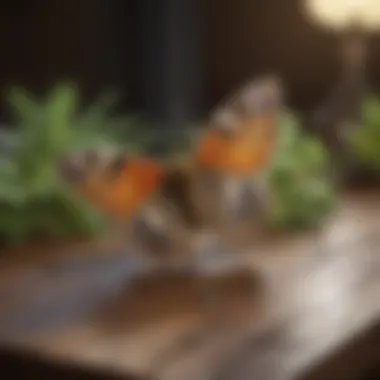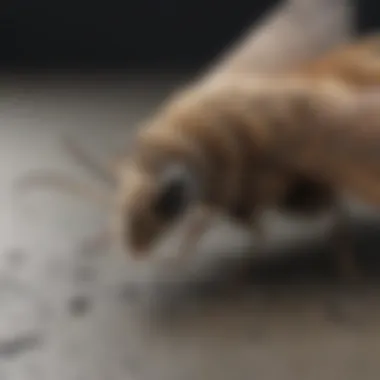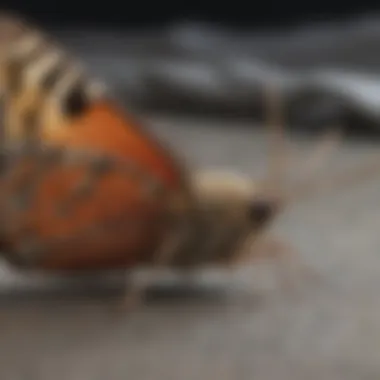Effective Strategies for Eliminating Clothes Moths


Intro
Clothes moths are a persistent problem in many homes, often causing significant damage to garments and textiles. Understanding how to effectively eliminate these pests is crucial for maintaining the integrity of valuable fabrics. This article will provide a comprehensive view of strategies to combat clothes moth infestations, focusing on identification, lifecycle, prevention, and various control methods.
Understanding the Pest
Identification
Clothes moths can often go unnoticed until they have already caused damage. The most common species affecting households are the Tineola bisselliella, known as the webbing clothes moth, and the Tinea pellionella, or the case-bearer moth. These insects are small, typically measuring around 1/2 inch in length. They have a golden or grayish-colored appearance, with shimmering wings that can blend into their surroundings. Identifying these pests at an early stage can prevent further infestations.
Life Cycle
The lifecycle of clothes moths consists of four stages: egg, larva, pupa, and adult. It begins when a female lays approximately 40 to 50 eggs, often near fibers that the larvae will consume. After around 4 to 10 days, larvae hatch and begin to feed on materials like wool, silk, or feather. The larvae are the most damaging stage, as they create holes in fabrics. The pupal stage lasts from a few days to a few weeks before transforming into adults, who emerge to repeat the cycle. Understanding this lifecycle is essential in targeting specific stages for effective control.
Pest Prevention Strategies
Environment Modification
Creating an environment that is unfavorable to clothes moths significantly reduces the risk of infestation. Consider the following measures:
- Regular Cleaning: Vacuum carpets, rugs, and upholstery regularly to remove larvae and eggs.
- Storage: Store out-of-season clothes in airtight containers. Use aromatic cedar or lavender sachets which mites find unpleasant.
- Humidity Control: Moths thrive in humid conditions; hence, maintaining low humidity levels can deter them.
Physical Barriers
Implementing physical barriers can also aid in prevention. Options include:
- Moth Traps: Sticky traps can help monitor and reduce adult populations.
- Mesh Screens: Installing mesh screens in windows and doors can prevent moths from entering the home.
- Sealing Cracks: Inspect and seal gaps around baseboards, windows, and doors where moths might enter or hide.
Control Methods
Chemical Control
In severe infestations, chemical control can be effective. Products containing pyrethrins or permethrin can kill moths on contact. However, it’s crucial to follow label instructions carefully, as misuse can lead to health hazards. Consider enlisting a professional pest control service that specializes in textile pests for optimal efficacy.
Biological Control
An alternative to chemical treatments is biological control. Some species of parasitic wasps, such as Trichogramma, can target moth eggs or larvae. These beneficial insects can reduce pest populations with minimal environmental impact.
"Biological control methods enable a sustainable approach towards pest management."
By carefully considering these strategies and implementing them effectively, homeowners can greatly reduce the risk and impact of clothes moth infestations. An informed and proactive approach ensures the longevity of cherished fabrics, preserving them for years to come.
Understanding Clothes Moths
Understanding clothes moths is essential for effective pest control in homes. These insects can cause significant damage to fabrics, making early detection and control a priority. Knowing their lifecycle helps in identifying infested areas and determining the best approach to eliminate them.
The Lifecycle of Clothes Moths
Clothes moths go through four distinct life stages: egg, larva, pupa, and adult. The female moths lay tiny eggs, usually in dark, undisturbed areas. Upon hatching, the larvae are the most damaging stage, as they feed on fabric fibers. This feeding behavior continues for several weeks, during which they can cause extensive damage. After they mature, they pupate and eventually emerge as adults, ready to continue the cycle. Each stage serves to reinforce the necessity for comprehensive control efforts throughout every phase.
Identifying Clothes Moths
Identifying clothes moths starts with recognizing their physical characteristics. Adult moths are small, measuring about half an inch long, with elongated wings that often appear golden or yellowish. It’s crucial to distinguish them from similar insects, like pantry moths. Additionally, paying attention to the signs of infestation can be helpful. Look for webbing or small holes in fabrics, as well as larvae, which are creamy-white and can be found in dark corners or within clothing folds.
Behavioral Patterns
Understanding the behavioral patterns of clothes moths is vital for effective prevention. They are attracted to natural fibers, such as wool and silk, making certain textiles more vulnerable. Moths prefer to lay their eggs in dark, quiet places, so regular checks in attics, closets, and other seldom-used spaces are essential. Knowing that adult moths are not as damaging as larvae can shift the focus on measures that target the larval stage for better success.


The significance of early identification lies in preventing extensive damage to valuable clothing and fabrics.
In summary, gaining an understanding of clothes moths can greatly improve pest control strategies. The lifecycle reveals when moths are most vulnerable, identification assists in recognizing their presence, and behavioral insights aid in carefully targeted preventive measures.
Chemical Control Methods
Chemical control methods are essential in combating clothes moth infestations. When infestations are severe, these methods provide a swift and effective way to eliminate adult moths and their larvae. However, using chemicals requires careful consideration. It’s crucial to assess not only the effectiveness of these products but also their safety for people and pets in the home environment.
Insecticides
Insecticides are potent tools in the battle against clothes moths. They are specifically formulated to target pests, disrupting their lifecycle and preventing reproduction. These products come in various forms such as sprays, powders, and granules.
When choosing an insecticide, it is important to look for ones that are labeled as effective against moths, like those containing pyrethrins or pyriproxyfen. These ingredients can kill adult moths on contact and provide residual effects that continue to work against new infestations. However, the user must follow the application instructions meticulously to ensure safety and efficacy.
Pesticide Sprays
Pesticide sprays are widely used for immediate control of moth populations. These sprays can penetrate fabrics and hard-to-reach areas where moth larvae hide. Look for insecticide sprays that are specifically designed for indoor use, minimizing risks to non-target species and ensuring effective treatment without lingering odors.
When applying pesticide sprays, it’s best to:
- Test a small, hidden area on fabrics for discoloration or damage.
- Allow treated areas to dry completely before use.
- Ventilate the room well during and after application to disperse any toxic fumes.
Additionally, some sprays offer synergists which enhance the effectiveness of the active ingredients, providing quick knockdown and extended control.
Foggers and Fumigation
Foggers and fumigation techniques serve as a last resort for eliminating clothes moths in severe infestations. These methods create a mist that distributes the insecticide throughout the treated area, reaching cracks and corners that other methods may miss.
Using foggers effectively involves:
- Removing food and pets from the area before treatment.
- Covering furniture and surfaces to protect them from the chemicals.
- Sealing off the room to prevent the mist from escaping.
It is paramount to follow manufacturer guidelines regarding evacuation time and re-entry precautions. Although effective, fogging can contaminate surfaces and should be used judiciously. Health concerns arise especially for those with respiratory issues, thus understanding the implications of such methods is necessary.
In summary, chemical control methods stand out for their rapid action against clothes moths. While they are invaluable for immediate relief, thoughtful consideration regarding their application and potential risks is paramount in ensuring safety and effectiveness.
Natural Remedies
Natural remedies for eliminating clothes moths serve as a crucial alternative to chemical solutions. These methods are often seen as more environmentally friendly and safer for households with children and pets. The effectiveness of these remedies can vary, yet many users report positive results when consistently applied. They can be easily incorporated into regular home maintenance routines, providing a sense of comfort and control over pest management.
Essential Oils
Essential oils such as lavender, rosemary, and peppermint have been shown to repel clothes moths effectively. Their potent fragrances not only add a pleasant aroma to your storage areas but also act as powerful deterrents. When using essential oils, it is important to dilute them properly before application. One effective method involves mixing a few drops of the chosen oil with water in a spray bottle and lightly misting your fabrics and storage areas. Additionally, placing saturated cotton balls in closets or drawers can provide continuous protection.
- Lavender oil is particularly favored, not only for its repellent qualities but also for its calming effects on human inhabitants.
- Use rosemary oil to disrupt the moth’s ability to locate fabrics.
- Peppermint oil can also serve a dual purpose, as it repels other pests, enhancing your overall pest management strategy.
Herbal Repellents
Herbs have long been used in traditional practices to ward off unwanted pests. Common household herbs like bay leaves, thyme, and cedar are known for their pest-repelling properties. You can create sachets filled with these herbs and place them in closets or drawers. The strong scents of these herbs disrupt the moth’s natural behavior.
Benefits of Herbal Repellents:
- They are non-toxic and safe for humans and pets.
- Easily accessible and cost-effective, making them a practical choice for many households.
- Each herb has a unique aroma that not only wards off moths but may also freshen up storage spaces.
Diatomaceous Earth
Diatomaceous earth (DE) is a natural powder made from the fossilized remains of tiny aquatic organisms. It works by dehydrating insects that come into contact with it. When using diatomaceous earth, it is essential to apply it directly in areas where you suspect moth activity. This can be around baseboards, in closets, or on shelving. It is advisable to use food-grade diatomaceous earth to ensure safety for household use.


- Apply a thin layer of this powder and reapply regularly, particularly after cleaning activities that may disturb its effectiveness.
- Avoid excessive moisture in areas treated with DE, as it loses efficacy when wet.
Diatomaceous earth is not a quick fix; it may take several days to see results. Ensure to combine it with other strategies for optimal pest control.
Natural remedies can be an integral component of an effective strategy against clothes moths. While they may not provide instant results, their safe and holistic approach fits well into the lifestyles of homeowners looking to maintain pest-free environments naturally.
Preventive Measures
Preventive measures play a crucial role in the battle against clothes moths. Understanding and implementing these strategies can significantly reduce the risk of infestations before they occur. The advantages of adopting preventive measures are numerous; they not only protect fabrics but also save on potential costs associated with treatments and repairs. Addressing the topic of prevention, one uncovers methods that are simple yet effective in maintaining a moth-free environment.
Proper Storage Techniques
Storing clothing and textiles properly is essential for moth prevention. Clothes should be washed or dry cleaned before storage to eliminate any eggs or larvae that may be present. Use airtight containers, such as vacuum bags or plastic bins with tightly sealed lids. Avoid cardboard boxes, as these can attract moisture and pests. Encourage airflow by using garment bags made from breathable materials for hanging clothes.
Ensure to store seasonal clothing in a cool, dark place, as moths prefer to lay their eggs in undisturbed areas. Regularly inspect these items during storage, looking for any signs of damage or insects. By taking these steps, one can significantly reduce the likelihood of moth activity in stored fabrics.
Regular Cleaning Habits
Maintaining a clean living space is vital. Regular vacuuming of carpets, rugs, and upholstery helps eliminate eggs and larvae that may have settled invisibly. Pay attention to areas where clothes are stored, such as closets and drawers, and clean these frequently. Washing bedding and curtains also contributes to a clean environment.
It is helpful to use a lint roller in areas where pets may shed, as their fur can attract moths. As a general rule, aim to clean and check storage areas once every few months. These habits not only prevent moths but also contribute to a fresh and organized home.
Maintaining Low Humidity
Clothes moths thrive in humid conditions. Maintaining low humidity levels in the home is a significant preventive measure. Use a dehumidifier or air conditioning to control moisture, keeping indoor levels below 50%. Checking areas such as basements and attics for moisture accumulation is important as these spaces can often become breeding grounds for moths.
To further manage humidity, proper ventilation in all rooms can help air circulation. Using moisture-absorbing products, such as silica gel packs, can also be beneficial in problem areas. These actions create an unfavorable environment for clothes moths and help to protect belongings effectively.
By implementing these preventive measures, one can significantly reduce the risk of clothes moth infestations, ensuring the longevity of fabrics in the household.
Monitoring and Detection
Monitoring and detection play a crucial role in managing clothes moth infestations. Understanding how to effectively monitor for these pests allows homeowners to catch infestations early, thus preventing extensive damage to valuable fabrics. Detection practices can be simple yet effective, making them accessible for the average person. The earlier moths are identified, the easier it is to control their population.
Using Traps
Traps are an effective tool in detecting clothes moths. Sticky traps and pheromone traps can provide clear indicators of moth presence. Sticky traps capture adult moths, allowing you to visually assess activity levels in a given area. Pheromone traps specifically attract male moths, disrupting their mating process while also stating the infestation’s severity.
Place traps in areas prone to moth activity, such as closets, attics, and around fabric storage. Regular replacement is essential to maintain effectiveness. By monitoring these traps, you can gauge whether the infestation is growing or if your control measures are working.
Routine Inspections
Regular inspections of clothing storage areas are vital. Examine all garments, especially those made from natural fibers such as wool, silk, or cotton. Look for signs of moth larvae or adult moths, as well as webbing or holes in the material.
At least once a month, inspect your storage methods and make adjustments when necessary. Don't forget to check seasonal items stored away during different parts of the year. Maintaining this habit can greatly reduce the chances of allowing an infestation to take hold.
Signs of Infestation
Identifying signs of infestation is essential to take timely action. Look for the following indicators:
- Larvae: Small, caterpillar-like larvae are often found in or around affected clothing.
- Webbing: Silken threads in or around clothing indicate moth activity.
- Holes: Small holes or damaged areas in fabrics are significant signs of moths.
- Adult Moths: Spotting adult moths flying or resting can alert you to an active infestation.
By being vigilant about these signs, homeowners can act swiftly, reducing the overall impact of moths on their valuable clothing and textiles.
Professional Pest Control Services
Professional pest control services play a crucial role in effectively combating clothes moth infestations. While many approaches exist to deal with these pests, enlisting professional help can often yield more significant results, particularly in severe cases. Pest control technicians are trained in specific techniques and equipped with advanced tools that are not generally available to the average homeowner. They provide a thorough evaluation of the problem and can quickly identify the extent of the infestation, offering tailored solutions to each unique situation.


When to Seek Professional Help
Deciding when to seek help from professionals can be a challenging judgment call. Homeowners might be able to handle minor infestations through chemical or natural remedies. However, if the infestation is widespread or if DIY methods do not bring results, it is time to consult an expert.
Signs that indicate the need for professional intervention include:
- Visible adult moths or larvae in multiple areas
- Significant damage to fabrics or belongings
- Presence of eggs on clothing or in storage areas
Consulting a pest control service can save time and resources, allowing for targeted treatments and prevention steps that are more efficient in the long run.
Evaluating Pest Control Options
Not all pest control service providers are created equal. Therefore, when selecting a pest control service, consumers should evaluate several factors to ensure they receive quality care. \n
- Reputation: Research reviews and testimonials from previous clients. Trusted sources include Better Business Bureau and online platforms.
- Experience: Choose services that specialize in moth control. Ask about their experience with such pests.
- Techniques Used: Inquire about the methods they utilize. Ensure they offer safe and effective solutions, especially in homes with children or pets.
- Follow-Up Services: A good pest control company often provides follow-up inspections. This ensures that the treatment remains effective in the long term.
Gathering this information will help homeowners make informed decisions to find a dependable pest control solution.
Cost Considerations
Cost can be a significant factor when considering professional pest control services. Generally, prices vary based on the extent of the infestation, the size of the property, and the methods employed.
- Initial Inspection Costs: Many companies offer free consultations or charge a nominal fee for their initial inspection service. This is a good opportunity to assess the problem.
- Treatment Costs: The actual treatment can range widely. Typical costs might be from $150 to $500, depending on the severity of the infestation.
- Preventative Measures: Some companies also provide services for ongoing prevention. These are typically offered at a regular rate, which can vary based on frequency.
Understanding these cost factors can aid homeowners in budgeting effectively while ensuring their homes are moth-free.
Case Studies and Success Stories
Homeowner Experiences
Homeowners who have successfully dealt with clothes moth infestations often share lessons learned and strategies implemented. These personal testimonies highlight the effectiveness of certain pest control methods while also revealing common pitfalls to avoid.
One common thread among various homeowner experiences is the significance of early detection. For instance, a homeowner named Linda recounts her swift action once she noticed eggs in her wool sweater. She used a combination of natural remedies, such as a lavender sachet, and focused on regular vacuuming to minimize the risk of recurrence. Many report that swift detection and immediate responses led to successful outcomes, preventing extensive damage to their clothing.
Additionally, stories often mention the role of preventive measures. Thomas, another homeowner, emphasizes his habit of storing clothes in airtight containers during off-seasons. He found that this step significantly reduced the likelihood of any future infestations. In many cases, insights from these experiences demonstrate that proactive approaches can be just as effective as reactive measures.
Commercial Strategies
Beyond individual homeowners, commercial strategies provide useful lessons in addressing clothes moth challenges. Companies with large fabric inventories, such as high-end clothing retailers and hotels, face significant risks from moth infestations. Their approaches can offer insights into more scaleable pest control techniques.
For instance, a clothing retailer implemented a combination of chemical and natural solutions. After facing multiple infestations, management opted for a rigorous pest control plan that included frequent inspections, use of pheromone traps, and regular employee training on preventive tactics. This case underlines the necessity of strategy evaluation and adaptation based on ongoing results.
Moreover, a successful hotel chain developed an integrated pest management program. They partnered with pest control professionals to conduct periodic inspections, ensuring their textile collections remained free of moths. This collaborative approach emphasized the significance of expert knowledge when addressing infestations.
Learning from these commercial experiences provides homeowners with practical insights and enhances their understanding of effective pest control.
"Real-life examples not only highlight successful strategies but also reveal hidden challenges that others may face."
The End
The conclusion serves as an essential element in this article, encapsulating the vital insights obtained throughout discussions on clothes moths. This section highlights the primary strategies, tools, and practices outlined to tackle these pests effectively. A clear understanding of various control methods, from chemical solutions to natural remedies, is critical. Moreover, adopting preventive measures can significantly reduce the likelihood of future infestations, protecting valuable fabrics and ensuring a moth-free environment in homes.
Summary of Key Points
To sum up, several critical aspects emphasize how to approach and combat clothes moth issues:
- Understanding Lifecycle: Familiarity with the lifecycle and behavior patterns of clothes moths informs the choice of tactics employed against them.
- Chemical and Natural Methods: Knowledge of available chemical insecticides, along with natural alternatives such as essential oils and diatomaceous earth, equips homeowners with options that match personal preferences and needs.
- Preventive Measures: Employing preventive strategies, such as proper storage techniques, regular cleaning, and maintaining a dry environment, plays a key role in avoiding infestations.
- Monitoring Practices: Regular inspections and effective use of traps can provide insights into potential problems before they escalate.
Future Considerations
Looking ahead, a few considerations are paramount for maintaining a moth-free home:
- Innovative Solutions: As research progresses, newer pest control technologies may emerge, offering enhanced efficacy and safety. Staying updated on these developments can be beneficial.
- Sustainability Practices: Growing awareness of environmental impact encourages exploration of more organic approaches to pest control. Homeowners might consider integrating sustainable practices that align with health and ecological principles.
- Community Surveillance: Joining local groups or forums focused on pest management can foster shared knowledge and experiences. This communal approach fosters effective strategies and diverse remedies.
- Education on Lifecycles: Continually educating oneself about the behaviors and life cycles of moths may lead to quicker detection and response strategies in case of an infestation.







